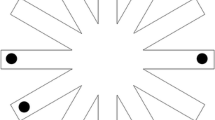Abstract
Mice belonging to the C57BL/6, DBA/2 (DBA), and C3H/He (C3H) strains were compared in three different eight0arm radial maze tasks requiring various degrees of spatial and nonspatial information processing. The results show that, on the standard radial maze task, C57 performed better than DBA, which, in turn, performed better than C3H. Fewer differences in the four-baited arm task and no difference in the cued version task were found between C57 and DBA, while C3H still performed more poorly. The high performance shown by C57 mice in all problems seems to be related to their ability to build up maze-running patterns based upon an optimal proportion of 45° angle turns, according to the demand of the situation. The cognitive and discriminative mechanisms involved in the solving of each task, the sensorial characteristics of the three strains, and the limits of an approach based upon neuroanatomical-behavioral correlations are discussed.
Similar content being viewed by others
References
Ammassari-Teule, M., and Caprioli, A. (1985). Spatial learning and memory, maze-running strategies and cholinergic mechanisms in two inbred strains of mice.Behav. Brain Res. 17:9–16.
Ammassari-Teule, M., and Gozzo, S. (1982). Selective effect of hippocampal and frontal cortex lesions on a spatial learning problem in two inbred strains of mice.Behav. Brain Res. 5:189–197.
Crusio, W. E., Schwegler, H., and Lipp, H.-P. (1987). Radial maze performance and structural variation of the hippocampus in mice: A correlation with mossy fibre distribution.Brain Res. 425:182–185.
Fredens, K. (1981). Genetic variation in the histoarchitecture of the hippocampal region of mice.Anat. Embryol. 161:265–281.
Henderson, N. D. (1968). Genetic analysis of acquisition and retention of a conditioned fear in mice.J. Comp. Physiol. Psychol. 65:325–330.
Hirsch, J. (1967). Behavior-genetic analysis at the chromosome level of organization. In Hirsch, J. (ed.),Behavior Genetic Analysis, McGraw-Hill, New York.
Ingram, D. K., and Corfman, T. P. (1980). An overview of neurobiological comparisons in mouse strains.Neurosci. Behav. Rev. 4:421–435.
Jarrard, (1982). Scopolamine impairs performance of a place and cue task in rats.Behav. Neur. Biol. 35:319–325.
Mandel, P., Ayad, G., Hermetet, J. C., and Ebel, A. (1974). Correlation between choline acetyltransferase activity and learning ability in different mice strains.Brain Res 142:97–103.
McCLearn, G. E. (1961). Genotype and mouse activity.J. Comp. Physiol. Psychol. 54:674–676.
Nedel, L., and MacDonald, K. (1980). Hippocampus: Cognitive map or spatial memory?Behav. Neur. Biol. 29:405–409.
Nagy, M. Z., and Misanin, J. R. (1970). Visual perception in the retinal degenerate C3H mouse.J. Comp. Physiol. Psychol. 72:306–310.
Oliverio, A. (1973). Genetic variation and heritability in a measure of avoidance learning in mice.J. Comp. Physiol. Psychol. 74:390–397.
Oliverio, A., Castellano, C., and Messeri, P. (1972). Genetic analysis of avoidance, maze and wheel-running behavior in the mouse.J. Comp. Physiol. Psychol. 79:459–473.
Olton, D. S., and Papas (1979). Spatial memory and hippocampal function.Neurophysiologia 17:669–682.
Renzi, P., and Sansone, M. (1971). Discriminated lever press avoidance behavior in mice.Comm. Behav. Biol. 6:315–321.
Rossi-Arnaud, C., Fagioli, S., and Ammassari-Teule, M. (1991). Spatial learning in two inbred strains of mice: Genotype dependant effect of amygdaloid and hippocampal lesions.Behav. Brain Res. 45:9–16.
Roullet, P., and Lassalle, J. M. (1992). Behavioural strategies, sensorial processes and hippocampal mossy fibres distribution in radial maze performance in mice.Behav. Brain Res. 48:77–85.
Schwegler, H., and Lipp, H.-P. (1983). Hereditary, covariation of neuronal circuitry and behavior: Correlation between the proportion of hippocampal synaptic fields in the regio inferior and two-way avoidance in mice and rats.Behav. Brain Res. 7:1–38.
Schwegler, H., Cruisio, W. E., Lipp, H.-P., and Heimrich, B. (1988). Water maze learning in the mouse correlates with variation of hippocampal morphology.Behav. Genet. 18:153–165.
Sidman, R. L., and Green, M. C. (1965). Retinal degeneration in the mouse.J. Hered. 56:23–29.
Upchurch, M., and Wehner, J. M. (1988). Differences between inbred strains of mice in Morris water maze performance.Behav. Genet. 18:55–68.
Upchurch, M., and Wehner, J. M. (1989). Inheritance of spatial learning ability in inbred mice: A classical genetic analysis.Behav. Neurosci. 103:1251–1258.
van Daal, J. H. H. M., Herbergs, P. J., Crusio, W. E., Schwegler, H., Jenks, B. G., Lemmens, W. A. J. G., and van Abeelen, J. H. F. (1991). A genetic-correlational study of hippocampal structural variation and variation of exploratory activities of mice.Behav. Brain Res. 43:57–64.
Author information
Authors and Affiliations
Rights and permissions
About this article
Cite this article
Ammassari-Teule, M., Hoffmann, HJ. & Rossi-Arnaud, C. Learning in inbred mice: Strain-specific abilities across three radial maze problems. Behav Genet 23, 405–412 (1993). https://doi.org/10.1007/BF01067443
Received:
Accepted:
Issue Date:
DOI: https://doi.org/10.1007/BF01067443




